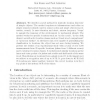Free Online Productivity Tools
i2Speak
i2Symbol
i2OCR
iTex2Img
iWeb2Print
iWeb2Shot
i2Type
iPdf2Split
iPdf2Merge
i2Bopomofo
i2Arabic
i2Style
i2Image
i2PDF
iLatex2Rtf
Sci2ools
HUC
2007
Springer
2007
Springer
Symbolic Object Localization Through Active Sampling of Acceleration and Sound Signatures
We describe a novel method for symbolic location discovery of simple objects. The method requires no infrastructure and relies on simple sensors routinely used in sensor nodes and smart objects (acceleration, sound). It uses vibration and short, narrow frequency ’beeps’ to sample the response of the environment to mechanical stimuli. The method works for specific locations such as ’on the couch’, ’in the desk drawer’ as well as for location classes such as ’closed wood compartment’ or ’open iron surface’. In the latter case, it is capable of generalizing the classification to locations the object has not seen during training. We present the results of an experimental study with a total of over 1200 measurements from 35 specific locations (taken from 3 different rooms) bstract location classes. It includes such similar locations as the inner and outer pocket of a jacket and a table and shelf made of the same wood. Nonetheless on locations from a single room (16 i...
| Added | 07 Jun 2010 |
| Updated | 07 Jun 2010 |
| Type | Conference |
| Year | 2007 |
| Where | HUC |
| Authors | Kai S. Kunze, Paul Lukowicz |
Comments (0)

